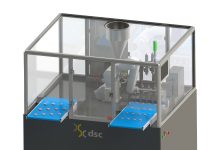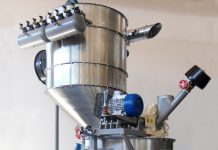The presence of pasta scrap recovery systems on the production lines for pasta are not mandatory both in terms of savings and in terms of respect for the environment.
In the kitchen of Italian families nothing could be wasted, once the pasta was hand made, some parts of the dough after the cutting were left over. These random cuts of maltagliati (poorly cut) became popular and turned to be a real pasta speciality. Italians have been utilizing their pasta scraps for years, since there was not reason to dump good dough pasta. Even today scraps or discards are unavoidable in industrial pasta production, but they can be recovered for their use as raw material. The scraps can vary from 3 to 12% or more in every sheet of pasta, pasta makers cannot afford such a dough waste, and need to reuse them somehow, reintroducing them in the production cycle. The presence of pasta scrap recovery systems on the production lines for pasta are not mandatory both in terms of savings and in terms of respect for the environment.
How they work
 There are basically three ways factories could dispose of their pasta scraps: transferring them as by-products for zootechnical purposes, transforming them to other products like cous cous or maltose syrup or reusing them in the production cycle. The systems aim to recover the fresh pasta scraps at the beginning and at the end of the production line and re-knead them to obtain products with unchanged characteristics, without white spots or poor cooking quality. The fresh pasta or the regenerated ground product mixed back in the kneading machine must be uniform and similar to the pre-kneading product. The main issue that these systems have to deal with is microbiological contamination, loss of moisture and traces of staffing ( i.e. ravioli staffing ). Basically there two main ways to recover the pasta scraps. Belts-based scraps retrieval system, when fresh pasta sheets are rotary cut, in ravioli production for instance, all the remaining scraps are carried back to the mixer machine to be kneaded with new fresh dough by means of an inclined conveyor with closed modular belt and containment edges which retrieves the dough. A fan may be used in order to make the scraps returning to the mixer. Microbiological contamination might take place at this stage as the moisture content is high. When dealing with drier material, the pasta scraps are re-milled to be easily rehydrated and re-kneaded. The resulting flour is mixed with semolina at rate of 10 to 15% maximum. The operation of crushing and re-milling is carried out by scrap milling units constructed according to the type of pasta to recover. The machine is essentially constituted by a loading hopper, the dough-scraps enter the hopper manually, fall from a pipe or by means of a transport belt. Scraps are firstly roughly grinded by one or two shafts with hammers for grinding them with alternating movement, a pressing unit smashes the scraps, follows a unit for the fine mincing of the scraps, making them suitable to be re-kneaded. The scope of the cochlea depends from the amount of product to treat, acts on a variable speed drive to reach the desired dimensions of the pieces, usually less than 2 mm, this facilitates the re-kneading. The semolina is now unloaded through the discharge auger of the machine, here a collecting belt takes the minced regenerated semolina to the pneumatic centrifugal fan conveyor to take the product to one or more kneading machines, feeding belt are also used. To achieve better performances, units can be provided with steel punched basket, through which scraps are pushed against the small holes, improving the shredding. The pasta scrap recovery system, depending on dimension and models can operate approximately from 200 to 800 kg per hour.
There are basically three ways factories could dispose of their pasta scraps: transferring them as by-products for zootechnical purposes, transforming them to other products like cous cous or maltose syrup or reusing them in the production cycle. The systems aim to recover the fresh pasta scraps at the beginning and at the end of the production line and re-knead them to obtain products with unchanged characteristics, without white spots or poor cooking quality. The fresh pasta or the regenerated ground product mixed back in the kneading machine must be uniform and similar to the pre-kneading product. The main issue that these systems have to deal with is microbiological contamination, loss of moisture and traces of staffing ( i.e. ravioli staffing ). Basically there two main ways to recover the pasta scraps. Belts-based scraps retrieval system, when fresh pasta sheets are rotary cut, in ravioli production for instance, all the remaining scraps are carried back to the mixer machine to be kneaded with new fresh dough by means of an inclined conveyor with closed modular belt and containment edges which retrieves the dough. A fan may be used in order to make the scraps returning to the mixer. Microbiological contamination might take place at this stage as the moisture content is high. When dealing with drier material, the pasta scraps are re-milled to be easily rehydrated and re-kneaded. The resulting flour is mixed with semolina at rate of 10 to 15% maximum. The operation of crushing and re-milling is carried out by scrap milling units constructed according to the type of pasta to recover. The machine is essentially constituted by a loading hopper, the dough-scraps enter the hopper manually, fall from a pipe or by means of a transport belt. Scraps are firstly roughly grinded by one or two shafts with hammers for grinding them with alternating movement, a pressing unit smashes the scraps, follows a unit for the fine mincing of the scraps, making them suitable to be re-kneaded. The scope of the cochlea depends from the amount of product to treat, acts on a variable speed drive to reach the desired dimensions of the pieces, usually less than 2 mm, this facilitates the re-kneading. The semolina is now unloaded through the discharge auger of the machine, here a collecting belt takes the minced regenerated semolina to the pneumatic centrifugal fan conveyor to take the product to one or more kneading machines, feeding belt are also used. To achieve better performances, units can be provided with steel punched basket, through which scraps are pushed against the small holes, improving the shredding. The pasta scrap recovery system, depending on dimension and models can operate approximately from 200 to 800 kg per hour.




